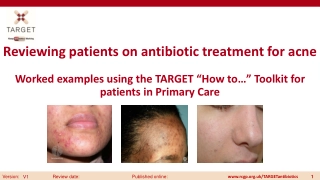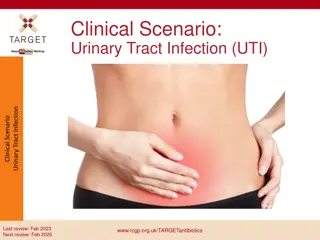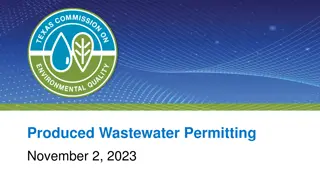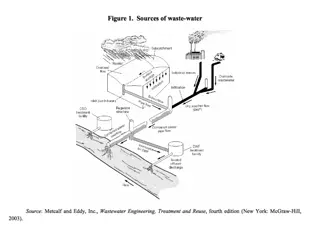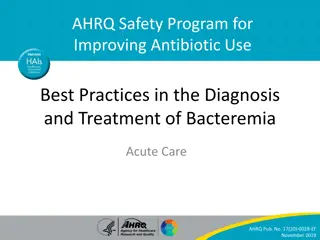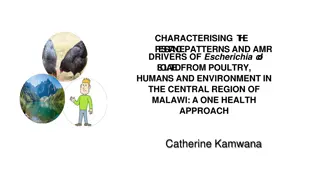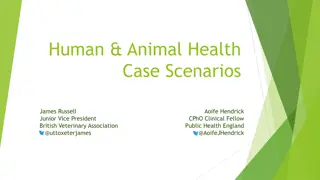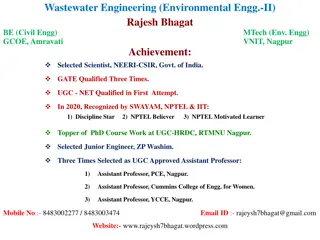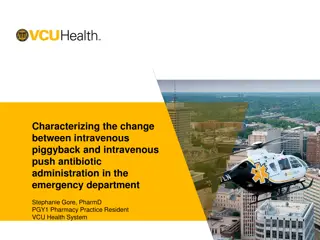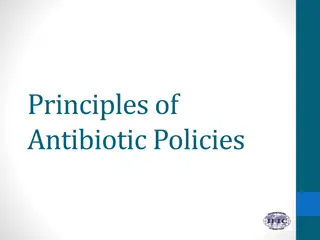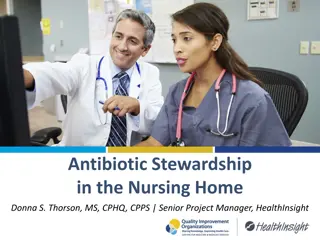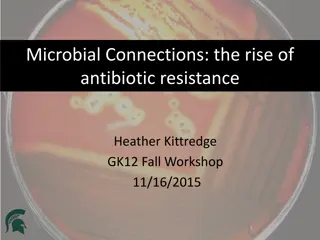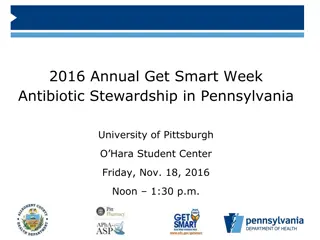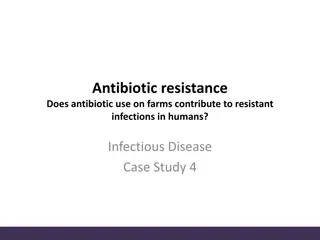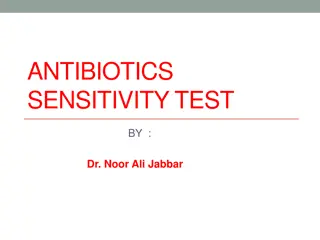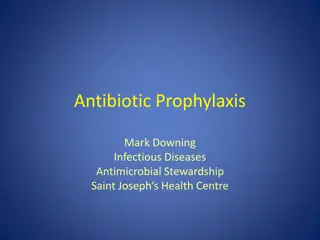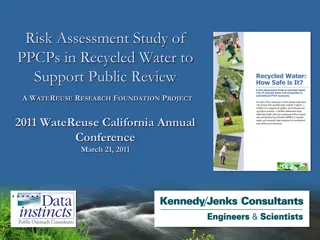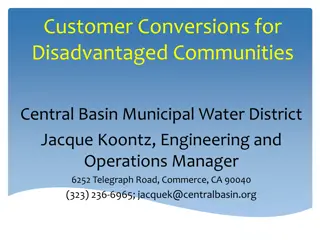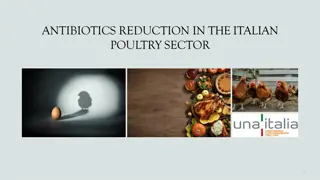Understanding Antibiotic Resistance in Recycled Wastewater
Explore the potential connection between recycled municipal wastewater and antibiotic resistance. Antibiotic-resistant bacteria pose a serious threat, fueled by factors like horizontal gene transfer and high antibiotic dosages in clinical settings. Environmental antibiotic resistance, linked to agricultural and clinical antibiotic use, highlights the need for better wastewater treatment to curb the spread of resistance genes.
Download Presentation

Please find below an Image/Link to download the presentation.
The content on the website is provided AS IS for your information and personal use only. It may not be sold, licensed, or shared on other websites without obtaining consent from the author. Download presentation by click this link. If you encounter any issues during the download, it is possible that the publisher has removed the file from their server.
E N D
Presentation Transcript
Recycled Municipal Wastewater and Antibiotic Resistance: Is there a Connection? Jean E. McLain, Associate Director University of Arizona Water Resources Research Center Statewide Water Quality Management Working Group October 11, 2016
Outline What is antibiotic resistance? Antibiotic resistance in the news
Outline What is antibiotic resistance? Antibiotic resistance in the news Current studies examining effects of anthropogenic chemical pollutants on environmental resistance Establishing guidelines for future resistance studies
Antibiotic Resistant Bacteria The ability of a bacterium to prevent an antibiotic from adversely affecting that isolate, strain, or group.
Antibiotic Resistant Bacteria The ability of a bacterium to prevent an antibiotic from adversely affecting that isolate, strain, or group. Horizontal Gene Transfer confers antibiotic resistance in response to selective pressure Clinical settings High antibiotic dosages
Antibiotic Resistant Bacteria The ability of a bacterium to prevent an antibiotic from adversely affecting that isolate, strain, or group. Horizontal Gene Transfer confers antibiotic resistance in response to selective pressure Clinical settings High antibiotic dosages WWTPs
Environmental Antibiotic Resistance Agricultural and clinical use of antibiotics Up to 75% excreted unaltered or as metabolites
Environmental Antibiotic Resistance Agricultural and clinical use of antibiotics Up to 75% excreted unaltered or as metabolites Many WWTPs not designed for the removal of these chemicals Recycled wastewater Biosolids Proposed that this is a key source of resistance to the environment
Antibiotic Resistant Bacteria Earliest antibiotics: naturally produced (e.g., Penicillin) ABR bacteria isolated from deep terrestrial subsurface (>250 m deep caves) and prehistoric (120,000+ YBP) ice cores
Antibiotic Resistant Bacteria Earliest antibiotics: naturally produced (e.g., Penicillin) ABR bacteria isolated from deep terrestrial subsurface (>250 m deep caves) and prehistoric (120,000+ YBP) ice cores ABR genes evolved in absence of selective pressure Competition for scarce resources
Resistance Analysis Methods: Bacterial Isolation/Culturing Broth microdilution methods Agar disc diffusion Clinical and Laboratory Standards Institute
Resistance Analysis Methods: Bacterial Isolation/Culturing Broth microdilution methods Agar disc diffusion Clinical and Laboratory Standards Institute PROS: Highly reproducible, robust Can assess at clinical levels CONS: Analyze a single isolate in each plate
Resistance Analysis Methods: Molecular ID of Genes Polymerase Chain Reaction (PCR), Quantitative PCR
Resistance Analysis Methods: Molecular ID of Genes Polymerase Chain Reaction (PCR), Quantitative PCR PROS: Can identify/quantify resistance genes in entire DNA sample Ability to quantify to single gene marker level CONS: No discrimination between live and dead bacteria
Resistance Analysis Methods: Molecular ID of Genes Polymerase Chain Reaction (PCR), Quantitative PCR PROS: Can identify/quantify resistance genes in entire DNA sample Ability to quantify to single gene marker level CONS: No discrimination between live and dead bacteria
How Did ABR Become Connected to Recycled Water Use? The Case of Flagstaff, Arizona 2012, Funded by private citizen 15 Recycled water samples; collected without guidance or permission Shipped to Virginia Tech University for analysis
How Did ABR Become Connected to Recycled Water Use? The Case of Flagstaff, Arizona Aug 13: Antibiotic resistance genes in pipe outflows of recycled water system
How Did ABR Become Connected to Recycled Water Use? The Case of Flagstaff, Arizona Aug 13: Antibiotic resistance genes in pipe outflows of recycled water system Sept 26: New Study Finds Antibiotic-Resistant Bacteria Genes in Flagstaff s Reclaimed Water
How Did ABR Become Connected to Recycled Water Use? The Case of Flagstaff, Arizona Aug 13: Antibiotic resistance genes in pipe outflows of recycled water system Sept 26: New Study Finds Antibiotic-Resistant Bacteria Genes in Flagstaff s Reclaimed Water Oct 11: Wastewater Snow-Making Could Breed Super-Bacteria Oct 15: Manmade Snow From Recycled Water May Contain Antibiotic Resistant Bacteria
How Did ABR Become Connected to Recycled Water Use? The Case of Flagstaff, Arizona Aug 13: Antibiotic resistance genes in pipe outflows of recycled water system Sept 26: New Study Finds Antibiotic-Resistant Bacteria Genes in Flagstaff s Reclaimed Water Oct 11: Wastewater Snow-Making Could Breed Super-Bacteria Oct 15: Manmade Snow From Recycled Water May Contain Antibiotic Resistant Bacteria Oct 17: Antibiotic Resistance Racing Downriver
How Did ABR Become Connected to Recycled Water Use? The Case of Flagstaff, Arizona December 2012: First meeting of Flagstaff City Manager s Expert Panel on Antibiotic Resistance
How Did ABR Become Connected to Recycled Water Use? The Case of Flagstaff, Arizona December 2012: First meeting of Flagstaff City Manager s Expert Panel on Antibiotic Resistance Panel Agrees on the Facts: 1. Antibiotic resistance genes resistant bacteria (DNA can indicate living or dead) 2. Recycled water pipe only: what about drinking/potable water pipes?
More Recently (March 2016) The Case of Los Angeles and CRE CRE thrives in soil and water AND in the human gut; mortality rate of 50%
More Recently (March 2016) The Case of Los Angeles and CRE CRE thrives in soil and water AND in the human gut; mortality rate of 50% Los Angeles Times Deadly Superbugs Get Stronger in the Sewers WWTPs serve as a luxury hotel for superbugs Chlorine is just not doing it
More Recently (March 2016) The Case of Los Angeles and CRE CRE thrives in soil and water AND in the human gut; mortality rate of 50% Los Angeles Times Deadly Superbugs Get Stronger in the Sewers WWTPs serve as a luxury hotel for superbugs Chlorine is just not doing it The Facts EPA sampled partially treated wastewater Antibiotic resistance genes
Does Recycled Municipal Wastewater Induce Antibiotic Resistance?
Gilbert Riparian Preserve Created in 1986, seven recharge basins receive tertiary-treated recycled water
Gilbert Riparian Preserve Created in 1986, seven recharge basins receive tertiary-treated recycled water Control site: irrigation retention pond at Maricopa Agricultural Center
Field Sampling over Two Years Gram positive Enterococcus spp. GI tracts of humans and animals; environmental persistence Great capacity for gene transfer
Field Sampling over Two Years Gram positive Enterococcus spp. GI tracts of humans and animals; environmental persistence Great capacity for gene transfer Emergence of multiple drug- resistant strains in clinical settings Ideal bacterial group for investigating the ecology of AR development
Laboratory Methods Isolates tested for resistance to 16 widely used antibiotics using CLSI broth microdilution methods
Laboratory Methods Isolates tested for resistance to 16 widely used antibiotics using CLSI broth microdilution methods
High Level Antibiotic Resistance Antimicrobial % Isolates with High-Level Resistance Groundwater 14.3 42.8 21.4 57.1 7.1 14.3 57.1 7.1 0.0 28.6 25.0 0.0 3.6 57.1 21.4 0.0 Wastewater 6.1 21.2 0.0 24.2 0.0 6.1 51.5 3.0 0.0 21.2 3.0 0.0 27.3 48.5 24.2 12.1 Tigecycline Erythromycin Tetracycline Ciprofloxacin Chloramphenicol Penicillin Daptomycin Vancomycin Streptomycin Nitrofurantoin Tylosin Tartrate Gentamycin Quinupristin/Dalfopristin Lincomycin Linezolid Kanamycin
High Level Antibiotic Resistance Antimicrobial % Isolates with High-Level Resistance Groundwater 14.3 42.8 21.4 57.1 7.1 14.3 57.1 7.1 0.0 28.6 25.0 0.0 3.6 57.1 21.4 0.0 Wastewater 6.1 21.2 0.0 24.2 0.0 6.1 51.5 3.0 0.0 21.2 3.0 0.0 27.3 48.5 24.2 12.1 Tigecycline Erythromycin Tetracycline Ciprofloxacin Chloramphenicol Penicillin Daptomycin Vancomycin Streptomycin Nitrofurantoin Tylosin Tartrate Gentamycin Quinupristin/Dalfopristin Lincomycin Linezolid Kanamycin
High Level Antibiotic Resistance Antimicrobial % Isolates with High-Level Resistance Groundwater 14.3 42.8 21.4 57.1 7.1 14.3 57.1 7.1 0.0 28.6 25.0 0.0 3.6 57.1 21.4 0.0 Wastewater 6.1 21.2 0.0 24.2 0.0 6.1 51.5 3.0 0.0 21.2 3.0 0.0 27.3 48.5 24.2 12.1 Tigecycline Erythromycin Tetracycline Ciprofloxacin Chloramphenicol Penicillin Daptomycin Vancomycin Streptomycin Nitrofurantoin Tylosin Tartrate Gentamycin Quinupristin/Dalfopristin Lincomycin Linezolid Kanamycin
Multi-Antibiotic Resistance Reclaimed Water Recharge Groundwater Recharge 70 60 Resistant Isolates (%) 50 40 30 20 10 0 Zero 1 to 3 4 to 6 7+ Total Number of Antibiotics
Multi-Antibiotic Resistance Reclaimed Water Recharge Groundwater Recharge 70 60 Resistant Isolates (%) 50 40 30 20 10 0 Zero 1 to 3 4 to 6 7+ Total Number of Antibiotics
Multi-Antibiotic Resistance Reclaimed Water Recharge Groundwater Recharge 70 60 Resistant Isolates (%) ? 50 40 30 20 10 0 Zero 1 to 3 4 to 6 7+ Total Number of Antibiotics
What Does This Mean? Antibiotic resistance: metabolically expensive
What Does This Mean? Antibiotic resistance: metabolically expensive Recycled Water, Biosolids = Adding Soil Carbon Does adding C at certain levels reduce bacterial competition and overcome the need to express resistance?
Antibiotic Resistance in the Environment: A Call to Action Published reports indicate that recycled water selects for resistant bacteria BUT many studies ignore natural antibiotic resistance and lack control sites
Antibiotic Resistance in the Environment: A Call to Action Published reports indicate that recycled water selects for resistant bacteria BUT many studies ignore natural antibiotic resistance and lack control sites We know that release of trace antibiotics and resistance genes is occurring, but propose that effects are unknown
Antibiotic Resistance in the Environment: A Call to Action Top researchers around the world; meetings 2014 and 2015 1. To reach consensus on methods 2. To train next generation in new methods 3. To address misinformation Five review papers in March/April issue of Journal of Environmental Quality
Antibiotic Resistance in the Environment: A Call to Action Top researchers around the world; meetings 2014 and 2015 1. To reach consensus on methods 2. To train next generation in new methods 3. To address misinformation World Health Organization: one of the most critical human health challenges of the next 100 years
Acknowledgements University of Arizona Channah Rock Leif Abrell University of Nevada-Las Vegas Dan Gerrity USDA-NIFA Collaborators Lisa Durso Dan Snow USDA-ARS Water Management and Conservation Programs USGS 104b, WateReuse Foundation, Arizona Department of Agriculture


